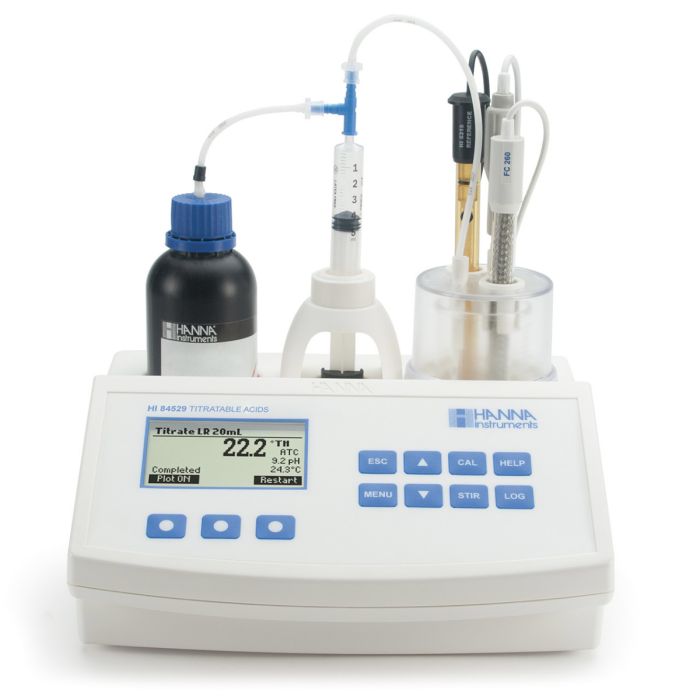There are two fundamentally different measurements of dairy products: titratable acidity and pH. pH is a measurement of hydrogen ion concentration while titratable acidity is the neutralizing capacity of a dairy product with NaOH. An increase in acidity can be caused by bacteria formation. Monitoring acidity is a way of determining the quality and freshness of dairy products. Acidity is determined by a pH endpoint titration using NaOH (sodium hydroxide), and is defined as the consumption necessary to shift the pH value from 6.6 (corresponding to fresh milk) to a pre-determined pH value. When using phenolphthalein as an indicator, a faint pink color change occurs at pH 8.3.
Titratable acidity is expressed in a variety of units based on the titration method performed. Each method varies in sample size and strength of NaOH used for the titration.
% Lactic Acid (%l.a.): Determined by taking a 20 mL or 20 g sample and diluting with twice its volume with deionized or distilled water. The sample is then titrated with 0.1 M NaOH to a phenolphthalein endpoint.
Degree Soxhlet Henkel (°SH): Determined by titrating a 50 mL sample with 0.1 M NaOH to a phenolphthalein endpoint.
Application-Specific Half-Cell pH Electrode
The HI84529 is supplied with the FC260B half-cell glass body pH electrode. A pH half-cell electrode consist only of the pH indicating electrode. There is no reference cell with a junction. The FC260B half-cell electrode uses low temperature (LT) glass with a spherical bulb and glass body. This design consideration is ideal for direct pH measurement or titration of dairy related products.
Low Temperature Glass Formulation
The glass tip uses a special LT glass formulation with a lower resistance of approximately 50 megaohms compared to general purpose (GP) with a resistance of about 100 megaohms. This is beneficial since many dairy products are stored at low temperatures. As the temperature of the glass decreases in the sample, the resistance of the LT glass will increase approaching that of GP glass at ambient temperatures. If using GP glass, the resistance would increase above the optimum resistance for the high impedance input of a pH meter. The FC260B is suitable to use with samples that measure from -5 to 100°C.
Reference Half-Cell
Most pH electrodes are combination pH electrodes in which both half cells are supplied in a single probe design. The reference cell of these electrodes typically have a junction made of ceramic, glass, or PTFE. The junction of a reference electrode provides the electrical pathway between the inner portion of the electrode and the sample The HI84529 is supplied with the HI5315 reference half-cell. The HI5315 has a skirted cone junction that allows for an extremely stable reference voltage with the sample. The HI5315 features a plunger design that can be used to flush any solids that have accumulated at the junction surface. The HI5315 can also be completely disassembled for cleaning. The ability to maintain a clean open junction allows for repeatable and accurate measurement.
Piston Driven Dosing Pump
The heart of the HI84529 is the piston driven burette pump. This type of dosing system uses a motor in which each dose is very precisely controlled and the volume dispensed is accurately determined. The piston driven burette is controlled dynamically so that the volume of titrant being dosed is automatically adjusted based on a voltage response of the previous dose. This type of dosing speeds up the titration process by allowing for more titrant to be dosed at the start of the titration and then very small doses as the endpoint is reached
Degree Dornic (°D): Determined by titrating a 100 mL sample with N/9 NaOH to a phenolphthalein endpoint.
Degree Thörner: Determined by taking a 10 mL sample and diluting with twice its volume with deionized or distilled water. The sample is then titrated with 0.1 M NaOH to a phenolphthalein endpoint.

